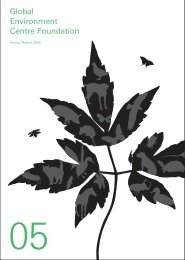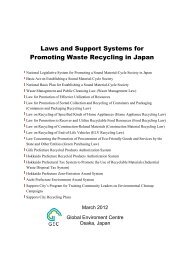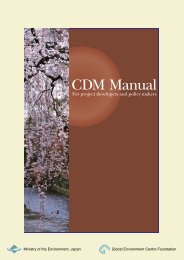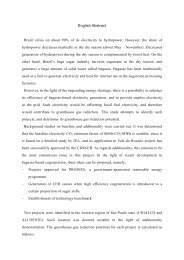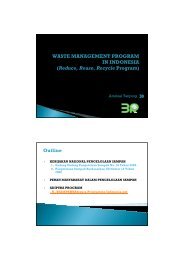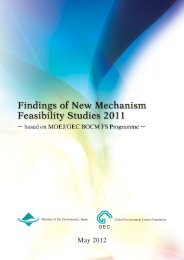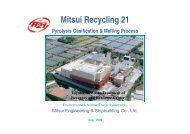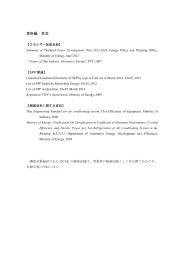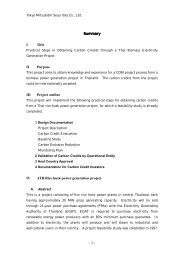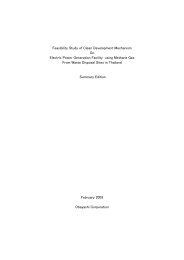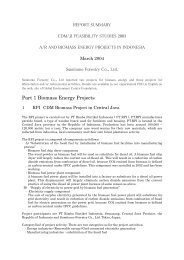PDF File - GEC
PDF File - GEC
PDF File - GEC
You also want an ePaper? Increase the reach of your titles
YUMPU automatically turns print PDFs into web optimized ePapers that Google loves.
verifiable information that indicates that the pool is not a source.<br />
(4) Use of IPCC good practice guidance<br />
According to the JI guidelines, JI projects aimed at enhancing removals shall conform to definitions,<br />
accounting rules, modalities and guidelines under Article 3, paragraphs 3 and 4, of the Kyoto<br />
Protocol. Decision 16/CMP.1, paragraph 2, states that good practice guidance, and methods to<br />
estimate, measure, monitor and report changes in carbon stocks and GHG emissions and removals<br />
resulting from LULUCF activities, as developed by the Intergovernmental Panel on Climate Change<br />
(IPCC), shall be applied by Parties, if decided in accordance with relevant decisions of the COP/MOP.<br />
According to decision 17/CMP.1, paragraph 1, Parties included in Annex I to the Convention that have<br />
ratified the Kyoto Protocol shall apply for the first commitment period the good practice guidance<br />
for LULUCF, as developed by the IPCC [Guidelines for Users of the JI LULUCF PDD Form Version 02<br />
(JISC06), Page 10].<br />
(5) Project boundary<br />
According to the Guidance on criteria for baseline setting and monitoring (Version 01), in the case of<br />
a JI LULUCF project, the project boundary shall:<br />
(a) Geographically delineate the JI LULUCF project under the control of the project participants. A<br />
JI LULUCF project may contain more than one discrete area of land. In this case:<br />
• Each discrete area of land should have a unique geographical identification;<br />
• The boundary should be defined for each discrete area and should not include the areas in<br />
between these discrete areas of land;<br />
(b) Encompass all GHG emissions and removals which are:<br />
• Under the control of the project participants;<br />
• Reasonably attributable to the project; and<br />
• Significant;<br />
(c) Account for all changes in the following carbon pools: above-ground biomass, below-ground<br />
biomass, litter, dead wood, and soil organic carbon. Project participants may choose not to<br />
account for one or more carbon pools if they provide transparent and verifiable information<br />
that indicates that the pool is not a source;<br />
(d) Be defined on the basis of a case-by-case assessment with regard to the criteria referred to<br />
in subparagraph (b) above. If a CDM-AM is used the project boundary shall be defined in line<br />
with the approved methodology.<br />
[JISC04, Annex 6, para. 12]<br />
(6) Leakage<br />
Leakage is the net change of GHG emissions and/or removals which occurs outside the project<br />
boundary, and that can be measured and is directly attributable to the JI project. In the case of JI<br />
LULUCF projects, only the increased GHG emissions and/or reduced removals outside the project<br />
boundary shall be taken into account [JISC04, Annex 6, para. 14].<br />
(7) Permanence<br />
Whereas tCERs and lCERs have been created to cope with non-permanence under the CDM, the<br />
credits issued from JI LULUCF projects are called ERUs, same as credits from GHG emission reduction<br />
JI projects. However, there are following differences from ERUs generated from GHG emission<br />
reduction JI projects:<br />
(a) ERUs are issued by each Party by converting assigned amount units (AAUs) 17 or removal units<br />
17 Total amount of AAUs of an Annex I Party is calculated from its base year emissions and emission reduction target<br />
81



